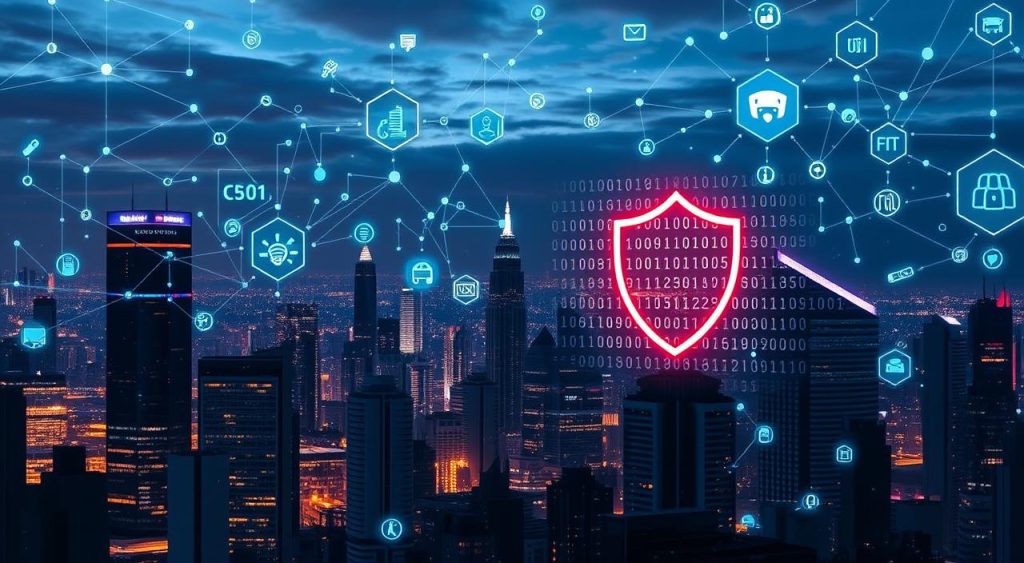As we head into 2025, it’s important to know the latest cybersecurity trends. These trends will shape the industry. With smarter cyber threats, companies must stay updated.
We’ll explore the main trends for 2025. This includes the growth of cybersecurity and the rise of quantum-resistant encryption. Knowing these trends helps us prepare for the future, as our predictions show.
Introduction to Cybersecurity Trends
Cybersecurity is always changing, and we must keep up with the latest trends. By knowing these trends, we can protect ourselves and our companies from cyber threats.
The Evolution of Cybersecurity: Where We Stand Today
Exploring today’s cybersecurity scene is key. We see new threats daily, with attacks becoming more targeted. This shows how fast the field is changing.
The threat landscape is getting more complex. Attacks are happening more often and are smarter. This means companies must stay alert and ready for what’s next.
Current Threat Landscape
Some major trends in cybersecurity today include:
- Rise of ransomware attacks
- Increased use of artificial intelligence by attackers
- More targeted and personalized threats
Major Shifts in 2023
2023 brought big changes in how we handle cybersecurity. There’s a push for proactive steps like strong security measures and regular checks. This trend is likely to grow, helping us stay ahead of threats.
Setting the Stage for 2025
Looking to 2025, cybersecurity will be shaped by today’s trends. By keeping up with these trends, companies can prepare for future challenges. This ensures a secure future for their operations.
Cybersecurity Trends to Watch Out for in 2025: Our Expert Analysis
As we look ahead to the new year, our experts say emerging cybersecurity trends will shape the future. With more cloud services, companies face a bigger risk of cloud attacks. It’s key to keep up with new cybersecurity threats.
Some important trends for 2025 include:
- More cloud services mean more cloud attacks
- The Internet of Things (IoT) will grow, making attacks easier
- New trends like quantum-resistant encryption and AI in defense will emerge
Experts believe 2025 will be a big year for cybersecurity. With new threats popping up daily, it’s vital to know the latest emerging cybersecurity trends. We must adapt our strategies to fight off risks.
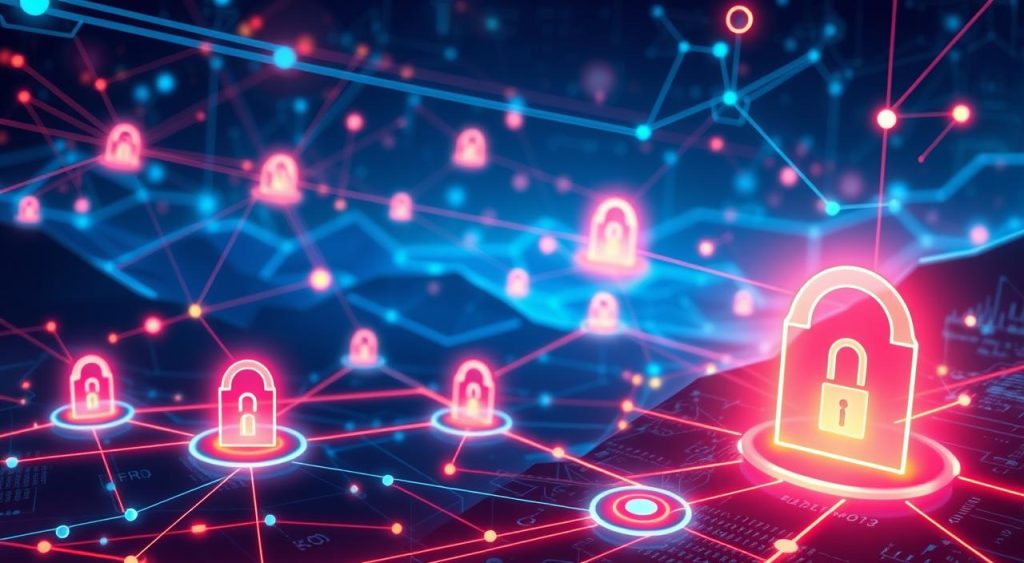
Staying ahead of the curve is critical in the ever-evolving world of cybersecurity. By understanding the latest trends and threats, organizations can take proactive measures to protect themselves and their assets.
The Rise of Quantum-Resistant Encryption
The cybersecurity trends report warns about quantum computing threats. It can break some encryption types. So, quantum-resistant encryption is now key. Experts predict more quantum computing soon.
Encryption is evolving fast. We’re moving to quantum-resistant methods. New standards like lattice-based and code-based cryptography are being used. They protect data from quantum attacks.
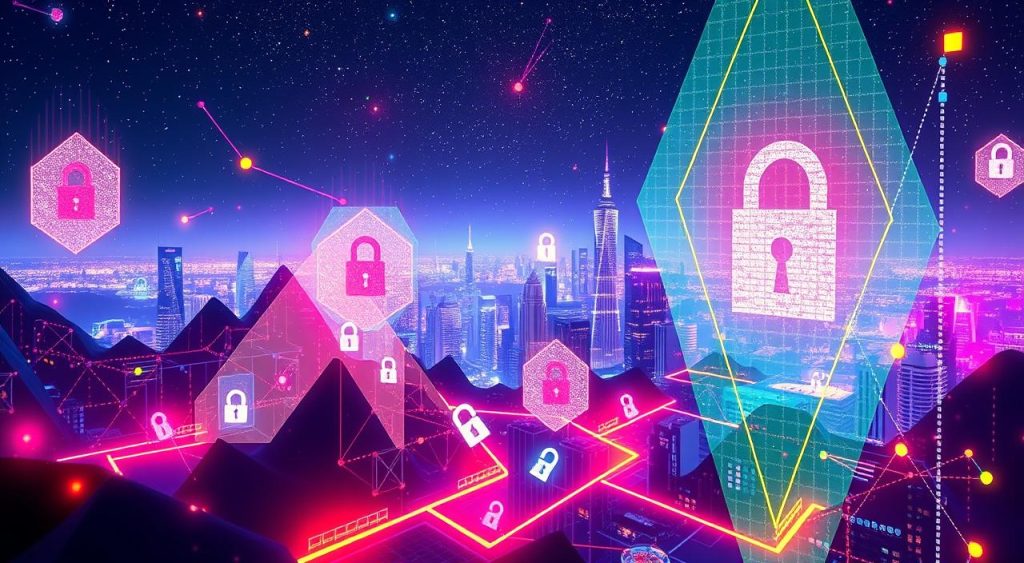
But, using quantum-resistant encryption is challenging. We need to update old systems and create new ones. Yet, it’s worth it to keep our data safe from cyber threats.
Quantum-resistant encryption has many benefits:
- It’s more secure than old encryption, making data harder to breach.
- It’s ready for quantum computers, keeping data safe as threats grow.
- It helps meet data protection rules, keeping businesses safe.
In short, quantum-resistant encryption is key for the cybersecurity trends report and cybersecurity forecast 2025. We must focus on it to protect our data.
| Encryption Method | Quantum Resistance | Security Level |
| Lattice-based cryptography | High | Advanced |
| Code-based cryptography | High | Advanced |
| Traditional encryption | Low | Basic |
Artificial Intelligence in Cyber Defense
We’re seeing big changes in cybersecurity technology advancements with artificial intelligence (AI). AI systems can look through lots of data to find patterns and oddities that might mean trouble. This makes them very useful in keeping our digital world safe.
AI is getting more important as we depend more on cybersecurity technology advancements. It helps spot and deal with threats fast. This is key because attacks are getting faster and smarter all the time.
Some big pluses of AI in cyber defense are:
- It helps find and fight threats better
- It makes responding to attacks quicker
- It makes security work more efficient
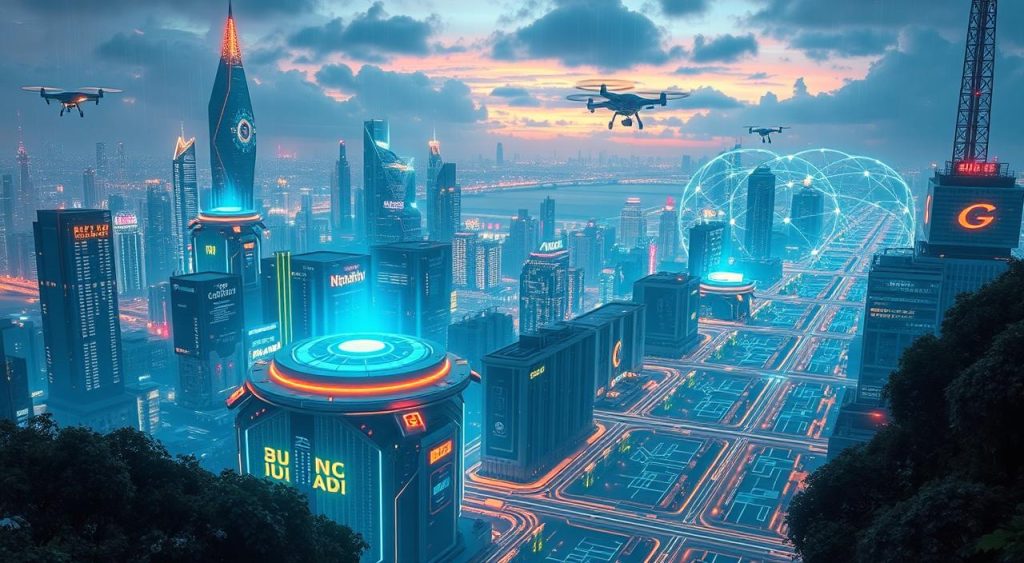
By using cybersecurity technology advancements, companies can stay one step ahead of new threats. It’s clear AI will be a big part of cyber defense’s future.
As experts, we know how vital cybersecurity technology advancements are for keeping safe online. By using AI for cyber defense, companies can face the changing threat world better. They can stay safe in our complex digital world.
Zero-Trust Architecture: Beyond Traditional Security Models
We’re seeing a big change in data protection trends as companies leave old security models behind. The growth of cybersecurity trends to watch out for in 2025 means we need stronger security. Zero-trust architecture is all about not trusting anyone, checking everything. It makes a safer place for companies to keep their data and systems safe from new threats.
At the core of zero-trust architecture are three main ideas:
- Default denial of access
- Least privilege access
- Continuous monitoring and verification
These ideas make sure everyone and everything, inside or outside the network, is checked before they get to important data and resources.
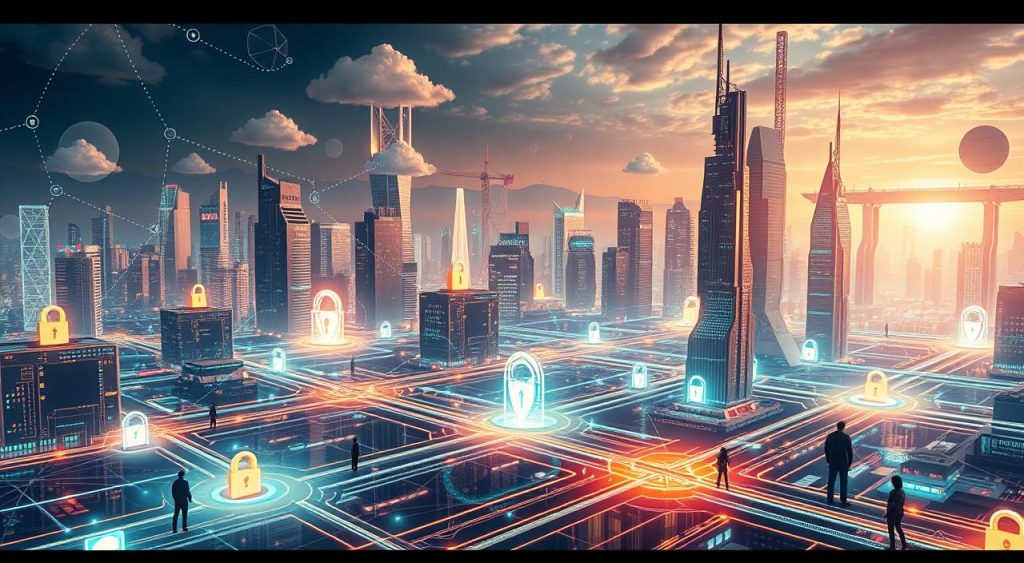
- Finding and sorting out sensitive data and resources
- Using multi-factor authentication and authorization
- Keeping an eye on and studying user and device actions
By using zero-trust architecture, companies can lower the chance of data breaches and cyber attacks. They can also keep up with the latestcybersecurity trends to watch out for in 2025.
| Benefits | Challenges |
| Improved security posture | Complexity in implementation |
| Reduced risk of data breaches | Higher costs |
| Increased visibility and control | Requires continuous monitoring and maintenance |
The Impact of IoT Security Requirements
Looking at cybersecurity predictions 2025, we see new security challenges with IoT devices. IoT security is now a top priority. These devices are often vulnerable to attacks, leading to data breaches and service disruptions.
There’s a rise in top cybersecurity trends focused on IoT security. It’s important to understand the risks of these devices. Key challenges include weak passwords, outdated software, and lack of encryption.
- Weak passwords and authentication
- Outdated software and firmware
- Lack of encryption and secure communication
To tackle these challenges, we need strong security measures. This includes regular software updates, strong passwords, and encryption. These steps help reduce the risk of IoT attacks and ensure a secure future for these devices.
As we move forward, we must consider cybersecurity predictions 2025 and IoT security’s impact. By staying informed and proactive, we can protect our devices and data from threats.
Cloud Security Evolution and Edge Computing
Looking ahead, cloud security and edge computing are key. Cloud services have brought new security issues. Protecting data in the cloud is now a top priority.
We’re moving towards distributed cloud security. This means data is processed and stored closer to us. It cuts down on delays and boosts real-time work.
This change has brought new threats, like protecting edge computing and managing hybrid environments. We must find new ways to keep up. Important steps include:
- Implementing strong security for edge devices
- Creating hybrid cloud security models that fit with what we already have
- Using artificial intelligence and machine learning to quickly spot and fight threats
By focusing on cloud security and edge computing, we can stay one step ahead. This ensures our data and systems are safe.
Biometric Authentication Advancements
Biometric authentication is gaining traction in the world of cybersecurity. It offers strong security and is easy to use. A recent cybersecurity trends report shows that methods like facial recognition and fingerprint scanning are becoming more common.
There’s been a big leap in biometric technology. Many companies are now using it to keep their systems and data safe. The advantages of biometric authentication include:
- Improved security: It’s more secure than using passwords.
- Convenience: It makes logging in easier without needing passwords.
- Reduced risk of data breaches: It helps protect against password theft and phishing.
Looking ahead, biometric authentication will be key in cybersecurity. Keeping up with the latest cybersecurity trends report helps organizations stay safe. They can make smart choices about their security and avoid threats.
Regulatory Compliance and Privacy Standards
Looking ahead to 2025, regulatory compliance and privacy are key. New global rules mean companies must follow strict standards. This is to avoid big fines and damage to their reputation.
There’s a big change in how companies handle cybersecurity. Now, they focus more on privacy. They’re setting up strong data protection plans to keep sensitive info safe.
Some important rules companies must follow include:
- GDPR (General Data Protection Regulation)
- CCPA (California Consumer Privacy Act)
- HIPAA (Health Insurance Portability and Accountability Act)
These rules can be tough to keep up with. But, with the right tech, companies can meet these standards.
By focusing on these rules, companies can keep their customers’ data safe. This builds trust in their brand. As we look to 2025, it’s vital for companies to keep up with the latest tech to stay compliant.
Regulations and Compliance
Regulations like GDPR, CCPA, and HIPAA are key for data protection. They ensure personal data is handled correctly. These rules help keep our data safe.
These laws are important for keeping our data secure. They make sure our personal information is protected.
The Human Element: Security Awareness and Training
People are often the weakest link in security. That’s why training is so important. It helps stop attacks like phishing.
Steps to boost security include:
- Regular training sessions to teach employees about new security threats and how to avoid them
- Creating a culture of security awareness in the workplace
- Doing regular security checks to find and fix weak spots
By focusing on security awareness and training, we can keep up with data protection trends and protect our organizations from threats.
Security is everyone’s job. We all play a big role in keeping our data and systems safe.
Security awareness and training are not a one-time thing. They need ongoing effort and improvement.
| Security Measure | Benefits |
| Regular Training Sessions | Employees become more aware and knowledgeable about security threats |
| Security Awareness Culture | The whole organization becomes more secure |
| Regular Security Audits | Weak spots are found and fixed |
Conclusion: Preparing for Tomorrow’s Cyber Landscape
Looking ahead to 2025, the cybersecurity world is changing fast. The cybersecurity trends to watch out for in 2025 might seem scary, but we must be ready. By keeping up with the latest cybersecurity predictions 2025, we can get ready for what’s coming.
We need to use new security tech like quantum-resistant encryption and biometric authentication. We also have to focus on people through security training. This mix of tech and training will help us fight off cyber threats.
As we go forward, remember that making our digital world safer is a never-ending job. By staying alert, adapting to new threats, and improving our security, we can face the cybersecurity trends to watch out for in 2025 and more. This will help us build a safer and stronger future for everyone.
FAQ
What are the key cybersecurity trends to watch out for in 2025?
In 2025, we’ll see big changes in cybersecurity. Expect more advanced encryption, AI in defense, and IoT security to grow. These changes will shape the industry.
How is the current threat landscape evolving, and how is it setting the stage for 2025?
Threats are getting smarter and more common. Ransomware and AI attacks are on the rise. These changes will define 2025’s cybersecurity scene.
What are the emerging cybersecurity trends that will impact organizations in 2025?
Watch for cloud services, IoT, and quantum encryption in 2025. These trends will change how we protect data and systems.
How will the rise of quantum computing affect cybersecurity, and what are the efforts to develop quantum-resistant encryption?
Quantum computing threatens our current encryption. Developing new, quantum-resistant encryption is key. We’ll look at the efforts to meet this challenge.
What is the role of artificial intelligence in cyber defense, and how is it being used to enhance security?
AI is vital in cyber defense. It can spot threats fast. AI systems analyze data to find patterns, helping protect against attacks.
What is zero-trust architecture, and how can it improve cybersecurity compared to traditional security models?
Zero-trust architecture is a new approach. It doesn’t trust anyone and checks everything. This makes it more secure than old models against today’s threats.
How are the security requirements for IoT devices impacting the cybersecurity landscape?
IoT devices bring new security risks. They’re often easy targets for attacks. Protecting them is critical to avoid data breaches and service disruptions.
What are the key developments in cloud security and edge computing, and how are they affecting cybersecurity?
Cloud and edge computing bring new security challenges. We’ll cover how to secure these areas, including distributed cloud security and edge computing protection.
How are advancements in biometric authentication impacting cybersecurity?
Biometric authentication is gaining ground. It offers strong security and convenience. We’ll look at its benefits and challenges in improving security.
What are the new regulatory compliance and privacy standards that organizations need to be aware of, and how can they ensure compliance?
New global regulations are emerging. Organizations must follow these, like GDPR and CCPA. We’ll discuss how to meet these standards.
Why is the human element so critical in cybersecurity, and how can security awareness and training help mitigate risks?
People are often the biggest security risk. Training and awareness can prevent attacks. Educating employees is key to better cybersecurity.

